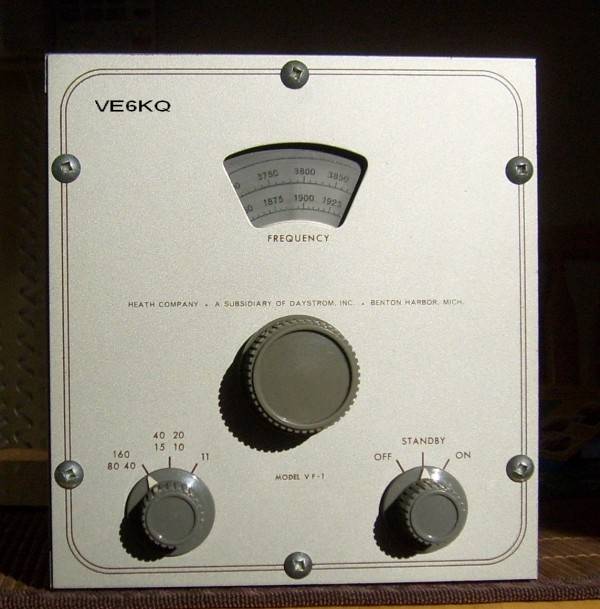
Back in the early 1960's I used a VF-1 VFO to drive a Heathkit AT-1 transmitter and later a WRL Globe Chief 90 transmitter. I did not build that VF-1 and I can not remember a lot of details about it. Recently, a vender at a local Flea Market had two VF-1's for sale at a very reasonable price. They both looked complete except one did not have a case. I bought both of them with the idea of making one good one with the parts available.

I was interested in comparing the frequency stability of the VF-1 with an HG-10B VFO I use with a Heathkit DX60B transmitter on AM. I was never all that happy with the stability of the HG-10B although it appears to be at least as good or better than most of the boat anchor VFO's that are used on 20 meter AM.
I am not going to go into a lot of details as to what was involved to get one "good" working VF-1 out of the two. It did take longer than expected and I used parts from both VFO's. One thing that did surprise me when I first turned it on was that when I checked the 40 meter scale it appeared to work in reverse. The VFO has two output bands, one on 160 meters and the other on 40 meters (and another output around 6.75 MHz for 11 meters). What I didn't initially notice is that the VFO had two 40 meter scales, one to be used with the 160 meter output and one for the 40 meter output and I was looking at the wrong scale.
The HG-10B VFO was usable on 20 meters after about a five minute warm-up but you had to check and correct for drift before each transmission at least for the first hour or so. After that it did not have to be checked as often. I use a Drake R-4B receiver to do that. The Drake is quite stable even after it is initially turned on. The HG-10B would drift down about 4 KHz in the first 4 hours of operation and then "stabilize".
The drift characteristics of the VF-1 are different. It appears to drift just about as much as the HG-10B VFO but it does it mostly in the first half hour after powering it up. During this time it makes it unusable on 20 meters. After the first half hour it is usable but you had to check and correct for drift before each transmission. After an hour warm-up it has pretty much stabilized and does not move much after that.
I plan to use the VF-1 VFO in place of the HG-10B for a while to see how it works out. I prefer the dial tuning characteristic of the VF-1 over the HG-10B.
I power the VFO's using an external power supply. Both the VFO's were designed to be powered off of the transmitter it was intended to be used with. The VF-1 originally used a OA2 VR tube. I replaced it with an OB2 (105V) and selected an appropriate limiting resistor. In my situation it is more convenient to run it this way. The VF-1 uses one other tube, a 6AU6 as the oscillator.